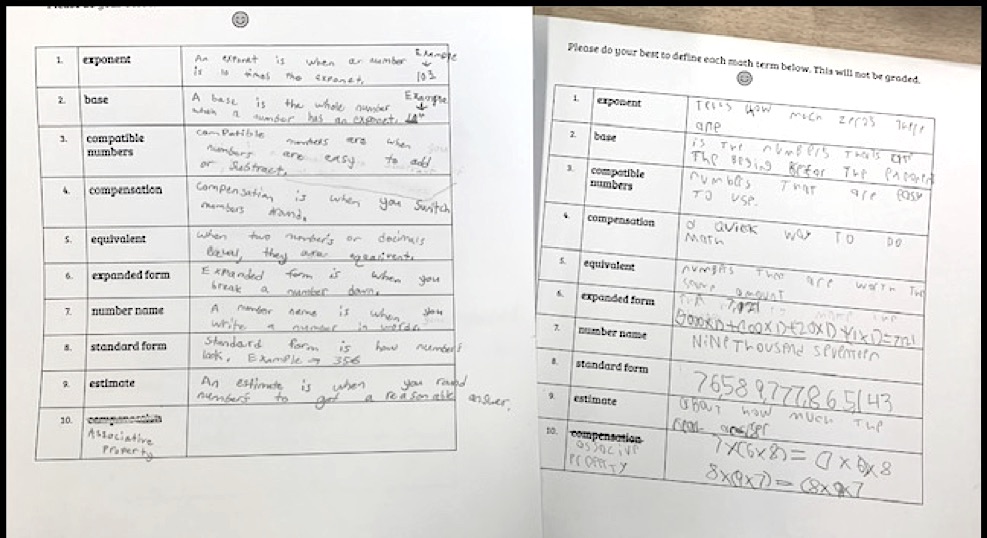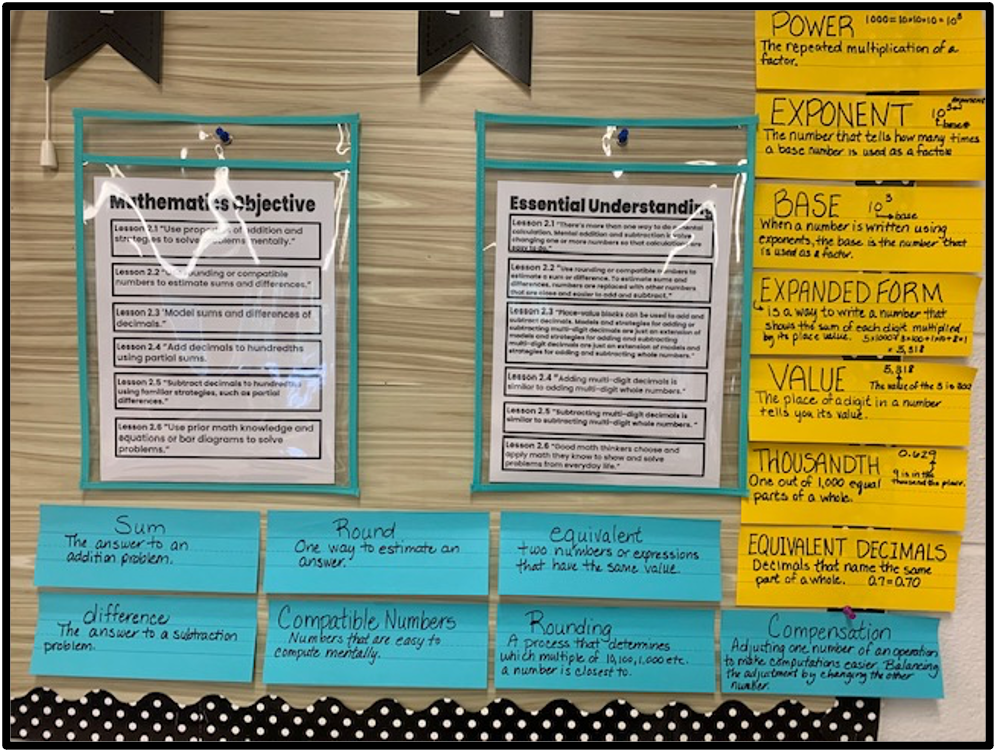How We Pumped Up Our Math Vocabulary Study
By Kathleen Palmieri

As the math curriculum advances, so does the terminology that is used in each unit. While logic and skill are two important elements in advancing math knowledge, students also need to be immersed in the language of math.
In the past I’ve wondered how well students were understanding some of the complex math terms that are used in our math textbooks. However, it was at the beginning of this new school year that I truly found students struggling to grasp the meaning of our math vocabulary.
So I decided to do a little action research and compose a list of math terms that students would be expected to understand as we began to explore this year’s curriculum.
What my research revealed
I pulled 10 words ranging in complexity from our math textbook to create a “show what you know” type of activity. The words I chose were:
- exponent
- base
- compatible numbers
- compensation
- equivalent
- expanded form
- number name
- standard form
- estimate, and
- Associative Property of Addition
Looking back on how students performed with a particular word problem on the first test, I was curious to see if there was a correlation between knowing math terminology and success in solving the problem.
What I found was that 40% of the students had a satisfactory understanding of most of the words and could write a basic definition, 30% could use numbers to show their understanding, 20% could define seven of the less complex words, and 10% truly struggled to show understanding of most words.
What I discovered in my students’ responses was that learning math terminology is more than studying a list of words. It is much more of an architecture of learning where concepts need to be explored and a pathway of understanding needs to be blazed before a mathematical term can be attached to establish true meaning. (Click to expand)
Involving students to develop strategies
After reading through my students’ responses, the next step was to have a class meeting, discuss the math terms, and have students brainstorm ways to help “pump up” our understanding of math vocabulary. Here is what we decided to do as a class:
►Student math glossary: Prior to beginning a new topic, as a class we will take a “Topic walk” and pull out any math terms that stand out as important to know. This will be more than a vocabulary list as students will have an active role in deciding what will go into their glossary as well as finding, discussing, and recording definitions with examples.
►Graphic Organizers: In language arts students are familiar with using graphic organizers that highlight a vocabulary word in the middle. Around the word are sentences and other related words. Using this type of organizer, the students will do the same with the math terms.
►Math Word of the Day/Week: Depending on the length of a particular concept, as a class we came up with having a math word to focus on for a day or for a week. To add a fun twist, students will tally how many times the word is used and how it is used. Examples include in a word problem, during a class discussion, in a small group math activity, etc.
►Student-created vocabulary posters: Adding art to math vocabulary seems to have truly engaged my students. Bubble letters, examples of problems and definitions with graphics are truly fun “math” activities. Students present and explain their term and then proudly display their poster in the classroom.
►Math word wall: This was an overwhelming hit idea during our discussion. Students felt word walls helped them remember vocabulary in reading. So they decided they wanted to create a math word wall. Students now take turns writing on large, colorful Post-its and affixing the terms to one of the classroom bulletin boards.
►Closely analyze word problems as a class: Pull out the key words, create a strong written response, solve the problem.
►Incorporate math word games: Use the format of Pictionary where students can draw clues or “What’s My Term?” where students verbally give clues as others listen.
Better vocabulary = better math performance!
My most important takeaway: encouraging the use of math vocabulary in our daily math lessons, discussions, and group work has a sizable payoff in student success. Much like reading and using context clues to build meaning as a reader, the language of math is a necessary ingredient in gaining conceptual understanding in mathematics.
Kathleen Palmieri is a National Board Certified Teacher and NBCT Professional Learning facilitator. She is a fifth grade educator in upstate New York who reviews and writes regularly for MiddleWeb. With a passion for literacy and learning in the classroom, she participates in various writing workshops, curriculum writing endeavors, and math presentations. As a lifelong learner, she is an avid reader and researcher of educational practices and techniques. Collaborating with colleagues and globally on Twitter and expanding her education adventures at www.kathleenpalmieri.com are ongoing practices.
Edutopia has republished portions of this article.

































Can you give some examples of graphic organizers you use? Does the glossary go in their interactive journals?
I have use the Frayer Model as a starter to help students.